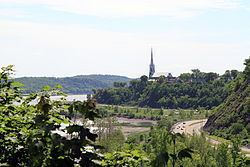 | ||
Sillery is a former city in central Quebec, Canada. It lies west of the Old City and was one of the municipalities amalgamated into an expanded Quebec City on January 1, 2002. Its former territory now forms part of the borough of Sainte-Foy–Sillery–Cap-Rouge. The name Sillery is still used to refer to the district, which contains some of the most highly sought after and wealthy properties in the city.
Sillery was named for Noël Brûlart de Sillery (1577–1640), Knight of Malta. A wealthy and successful French diplomat, he renounced worldly goods and became a Catholic priest. He provided the funds for the establishment in 1638 of a settlement for Native American (First Nations) converts to Catholicism.
The community was Canada's first Indian reserve, established at a cove where the Algonquin fished for eels. Originally named in honour of St. Joseph, the settlement became the home of up to 40 Algonquin Christian families, who lived there most of the year, excluding the hunting season. Missionaries to New France, such as Jacques Gravier, studied with the indigenous residents of Sillery to learn their languages before going to more distant settlements. By the early 18th century, he had compiled a nearly 600-page dictionary of Kaskaskia Illinois-French. Many of the community's natives fell victim to epidemics of new infectious diseases, to which they had no natural immunity. The settlement was largely depopulated by the late 1680s.
Renamed Sillery in honour of its founder, the town later became important as a port for the lumber industry. The city of Sillery's motto was: "Non multa, sed multum," meaning, "Not many things, but much," a fit descriptor for the small enclave. From the land at the water's edge, including Anse au Foulon, site of the disembarcation of General Wolfe's successful army in the Battle of the Plains of Abraham, the community spread up to the top of the heights overlooking the Saint Lawrence River. In 1760 during the French and Indian War the Battle of Sainte-Foy was fought near Sillery during a French attempt to re-capture Quebec which had been taken by the British the previous year.
It houses Spencerwood, once the Vice regal residence of Quebec. The building known as Spencerwood was built in 1854 by the government of the Province of Canada, and was purchased by the Quebec Government in 1870 to serve as the residence of Quebec Lieutenant-Governors until 1966, when a major fire destroyed the main residence. Originally an estate named for the assassinated UK Prime Minister Spencer Perceval by his bastard son, Michael Henry Perceval, it was renamed the Bois de Coulonge in 1950 .
Commanding the bluffs just west of the city of Québec, in modern times Sillery was known principally for its quiet tree-lined streets, historic churches such as St. Michel de Sillery Church, views of the river, and several very old schools run by a variety of religious institutes. Its coat of arms (see link below) consisted of a red shield with a white Maltese cross in the upper right hand corner and a three-masted ship in the lower left.
On January 1, 2002, as part of a legislated amalgamation of cities across the Province of Quebec, Sillery ceased operations. Its territory is now a part of the Sainte-Foy—Sillery—Cap-Rouge Borough of Québec. Of the former municipalities that now comprise Québec, Sillery was relatively linguistically diverse. It had more anglophone citizens (4%) than the norm and the greatest proportion of allophones (5%) in the region.
According to the Canada 2006 Census:
